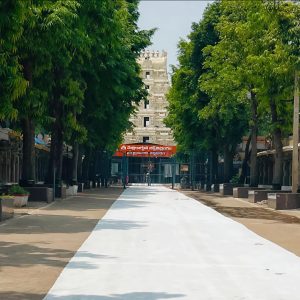About Srisailam
Srisailam, nestled amidst the picturesque Nallamala Hills of Andhra Pradesh, is a revered pilgrimage destination that blends spirituality, history, and natural beauty. Known as one of the 12 Jyotirlingas and one of the 18 Shakti Peethas, this sacred town attracts devotees and travelers alike. Whether you seek divine blessings or an escape into nature, Srisailam offers a unique experience.
Unveiling the Divine: A Journey to Srisailam Mallikarjuna Swamy Temple
Srisailam Mallikarjuna Swamy Temple, a unique abode where two of Hinduism’s most revered divine manifestations converge: a Jyotirlinga of Lord Shiva and a Shakti Peetha of Goddess Parvati lies. This post will take you on a virtual journey through this ancient temple, exploring its history, architecture, spiritual significance, rituals, and more.
The Confluence of Divinity: Jyotirlinga and Shakti Peetha
It is one of the twelve Jyotirlingas of Lord Shiva, a self-manifested pillar of light representing the infinite nature of Shiva. Simultaneously, it is one of the eighteen Maha Shakti Peethas, locations where parts of Goddess Sati’s body are believed to have fallen. Here, Lord Shiva is worshipped as Mallikarjuna Swamy, and Goddess Parvati as Bhramaramba Devi. This rare combination makes Srisailam an unparalleled spiritual magnet for devotees of both Shaivism and Shaktism.
Legend of Mallikarjuna: One popular legend states that a princess named Chandravati, while living on the hill, noticed a cow shedding its milk over a rock resembling a Shivling. Believing it to be Lord Shiva, she began worshipping it with jasmine flowers, locally known as “Mallika.” Thus, Lord Shiva came to be known as Mallikarjuna. Another legend connects it to Lord Kartikeya, who, after being displeased with his parents Lord Shiva and Parvati, came to reside here. When Shiva and Parvati followed him, they too made Srisailam their abode.
Legend of Bhramaramba Devi: The name “Bhramaramba” is fascinating. It translates to “Mother of bees.” The legend goes that a demon named Arunasura, who had a boon protecting him from two-legged and four-legged creatures, was devastating the world. To defeat him, Goddess AdyaShakti transformed herself into Bhramarambika, creating innumerable six-legged bees that annihilated the demon. Even today, a mystic buzzing sound is sometimes heard behind the temple’s granite walls, attributed to these divine bees.
History
The history of Srisailam Temple dates back centuries, with epigraphical evidence suggesting its existence from the Satavahana dynasty (2nd century AD). Over time, various powerful dynasties, including the Ikshvakus, Pallavas, Vishnukundis, Chalukyas, Kakatiyas, Reddys, and especially the Vijayanagara Empire, contributed significantly to its current magnificent structure.
Architecture
- Mukha Mandapa: A notable feature is the elaborate Mukha Mandapa, a closed hall with intricately sculpted pillars, built during the Vijayanagara period by Harihararaya II. Its interior boasts four rows of pillars, many adorned with silver coverings depicting various forms of Shiva.
- Veerasiromandapa: This unique mandapa, built by the Anavema Reddi, was historically used for “Veeracharam,” a practice where Veerasaivas would offer their heads, hands, or tongues to the deity.
- Shrines: The complex houses numerous shrines, with the most prominent being those dedicated to Lord Mallikarjuna and Goddess Bhramaramba. The Mallikarjuna shrine is believed to be the oldest, possibly dating back to the 7th century.
- Sahasra Linga: Legend states that Lord Rama commissioned the Sahasra Linga (1000 lingas) within the temple, while the Pandavas are said to have commissioned five other lingams.
Click Here to Explore Temple Timings, Pooja & Seva Details, Travel Info & Nearby Attractions.
